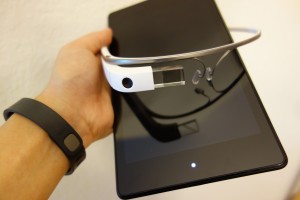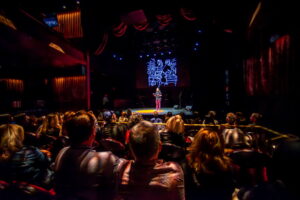 The dream of ubiquitous computing is not so much that computers will be everywhere. That’s the shallow interpretation. It was actually about how we’re going to deal with a world where there are computers everywhere; that is why Mark Weiser (who many people call the father of ubicomp) pushed for making computing invisible-in-use.
The dream of ubiquitous computing is not so much that computers will be everywhere. That’s the shallow interpretation. It was actually about how we’re going to deal with a world where there are computers everywhere; that is why Mark Weiser (who many people call the father of ubicomp) pushed for making computing invisible-in-use.
As an undergrad, I heard Mark Weiser’s name mentioned every once in a while at lab group meetings. When I read more about him, I decided that I wanted to work at PARC, where “ubiquitous computing” was born. While at Stanford in grad school, I interned at PARC and spent several years reading through the Stanford library archives on Mark Weiser’s work. It inspired me to dig deeper into how we can make computers less demanding of our attention and make them fade into the background of everyday experiences.

With friends like Wendy Ju and Bjoern Hartmann, we took on projects to explore how we might use computation to design automatic doors to be more welcoming (right) and leverage embodied cognition philosophies to encourage interaction designs that take human embodied experience more seriously.
 This is why I push for robotics to become so (quietly) useful that they become unremarkable. I continue to work on applying these ubicomp design values to human-robot interaction, finding ways to make people the stars of the show rather than robots (2024 TEDx Palo Alto talk).
This is why I push for robotics to become so (quietly) useful that they become unremarkable. I continue to work on applying these ubicomp design values to human-robot interaction, finding ways to make people the stars of the show rather than robots (2024 TEDx Palo Alto talk).
My publications in ubicomp include:
Takayama, L. (2017). The motivations of ubiquitous computing: Revisiting the ideas behind and beyond the prototypes. Journal of Personal and Ubiquitous Computing, 21, 1-13.
Takayama, L. (2012). Perspectives on agency: Interacting with and through personal robots. In Zacarias, M. & Oliveira, J. V. (Eds.), Human-Computer Interaction: The Agency Perspective. Springer.
[ PDF ]
Takayama, L. (2011). Toward making robots invisible-in-use: An exploration into invisible-in-use tools and agents. In Dautenhahn, K. (Ed.), New Frontiers in Human-Robot Interaction. Amsterdam, NL: John Benjamins, 111-132.
[ PDF ]
Takayama, L. & Nass, C. (2010). Throwing voices: The psychological impact of the spatial height of projected voices. Proceedings of Computer Supported Cooperative Work: CSCW 2010, Savannah, GA, USA, 91-94. [20% acceptance rate; nominated for best note]
[ PDF ]
Sohn, T., Takayama, L., Eckles, D., & Ballagas, R. (2009). Auditory priming for upcoming events. Extended Abstracts of CHI 2009, Boston, MA, USA, 4225-4230. [34% acceptance rate]
[ PDF ]
Sohn, T., Ballagas, R., & Takayama, L. (2009). At your service: Using butlers as a model to overcome the mobile attention deficit. Extended Abstracts of CHI 2009, 4219-4224. [34% acceptance rate]
[ PDF ]
Ju, W. & Takayama, L. (2009). Approachability: How people interpret automatic door movement as gesture. International Journal of Design, 3(2).
[ PDF ]
Ju, W., Takayama, L., & Nass, C. (2008). Approachability: How people interpret automatic door movement as gesture. Proceedings of Design and Emotion, Hong Kong, CN.
[ PDF ]
Danninger, M., Takayama, L., Wang, Q., Schultz, C., Beringer, J., James, F., Hofmann, P., & Nass, C. (2007). Can you talk or only Touch-Talk? A VoIP-based phone feature for quick, quiet, and private communication. Proceedings of the International Conference on Multimodal Interfaces: ICMI 2007, JP, 154-161.
[ PDF ]
 Klemmer, S. R., Hartmann, B., & Takayama, L. (2006). How bodies matter: Five themes for interaction design. Proceedings of Designing Interactive Systems: DIS 2006, USA, 140-148. [22% acceptance rate]
Klemmer, S. R., Hartmann, B., & Takayama, L. (2006). How bodies matter: Five themes for interaction design. Proceedings of Designing Interactive Systems: DIS 2006, USA, 140-148. [22% acceptance rate]
[ PDF ]
Danninger, M., Kluge, T., Robles, E., Takayama, L., & Wang, Q. (2006). The Connector service: Predicting availability in mobile contexts. Proceedings of the Workshop on Multimodal Interaction and Related Machine Learning Algorithms: MLMI 2006, USA, 129-141.
[ PDF ]
Jiang, X., Chen, N. Y., Hong, J. I., Wang, K., Takayama, L., & Landay, J. A. (2004). Siren: Context-aware computing for firefighting. Proceedings of Pervasive 2004, Austria, 87-105. [13% acceptance rate]
[ PDF ]
Takayama, L., Leung, L., Jiang, X., & Hong, J. I. (2004). You’re getting warmer! How proximity information affects search behavior in physical spaces. Extended Abstracts of Human Factors in Computing Systems: CHI 2004, USA, 1028-1029. [16% acceptance rate]
[ PDF ]
This is a subset of my publications. To see ’em all, go here.